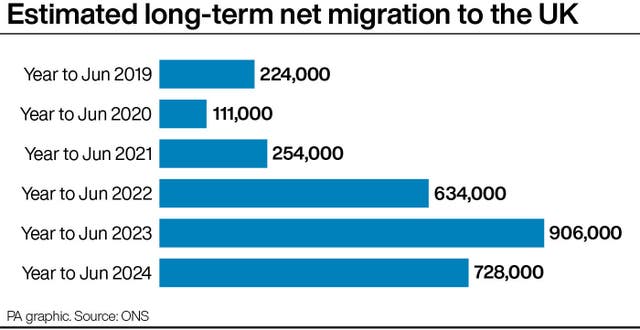Net migration drops 20% to 728,000 after hitting record 906,000
The Office for National Statistics published the latest revised figures on Thursday.

The Government accused the Conservatives of running “Britain as an experiment in open borders” as revised estimates revealed net migration to the UK hit a record 906,000 in 2023.
Office for National Statistics (ONS) figures indicated the measure for the difference between the number of people arriving and leaving the country reached the higher than previously thought peak in the 12 months to June last year, after being revised up 166,000 from the initial estimate of 740,000.
The estimates, covering the previous Conservative government’s administration prior to the general election, have since dropped by 20% and stood at 728,000 in the latest period for the year to June 2024.
Meanwhile, the cost of the UK’s asylum system has risen to £5 billion, the highest level of spending on record and up by more than a third in a year, according to separate Home Office data published at the same time.
The figures prompted Prime Minister Sir Keir Starmer to call a Downing Street press conference on Thursday afternoon. They also come after new Tory leader Kemi Badenoch admitted her party had failed on migration.
Downing Street said the statistics “show that the Government inherited a situation from the previous government where they had effectively run Britain as an experiment in open borders” and this happened “due to the policies and decisions taken by the last government”.
The Prime Minister’s official spokesman would not be drawn into saying whether Labour’s approach would be tougher than the Tories, but added that the Government had been “elected on a mandate to change the country and put the people’s priorities at the heart of delivery, and that means bringing down these record high levels of legal migration and tackling the root causes behind it”.
Home Secretary Yvette Cooper said net migration is “still four times higher than it was at the beginning of the last parliament and we are clear that it needs to come down” as she stressed the Government was taking action.

Earlier on Thursday, migration minister Seema Malhotra declined to say what level of net migration would be acceptable when repeatedly asked for a number.
Instead, she told BBC Breakfast that policy must be based on “a credible and serious plan” and the Government should not “just pull figures out of the air”.
The ONS said although remaining high by “historic standards”, net migration is “beginning to fall”.
Former home secretaries James Cleverly and Suella Braverman, who have both courted hopes of becoming Tory leader in the past, claimed credit for the drop in numbers while they led the Home Office.
But shadow home secretary Chris Philp said net migration “remains far too high” and the UK needs stricter border controls.

In a speech on Wednesday, Ms Badenoch said there had been a “collective failure of political leaders from all parties over decades” to grasp migration, adding: “On behalf of the Conservative Party, it is right that I as the new leader accept responsibility, and say truthfully we got this wrong.
“I more than understand the public anger on this issue. I share it.”
The revisions are as a result of the ONS continuing to review its net migration figures as more complete data becomes available as well as improving how it estimates the migration behaviour of people arriving in the UK from outside the European Union.
Better analysis of the number of people coming to the UK amid the conflict in Ukraine has also been taken into account.

This compares with 1.3 million who arrived in the UK in the year to June 2023 and 414,000 who left.
The drop in the overall level of net migration has been driven mainly by a fall in the number of dependants arriving in the UK on study visas from outside the EU.
ONS director Mary Gregory said long-term international migration to the UK had been at “unprecedented levels” since 2021, with the war in Ukraine and the immigration system brought in after Brexit among the reasons behind this.
“While remaining high by historic standards, net migration is now beginning to fall and is provisionally down 20% in the 12 months to June 2024.”





